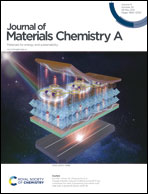Effective stability enhancement in ZnO-based perovskite solar cells by MACl modification†
Abstract
Low-temperature solution-processed ZnO has decided advantages in flexible and tandem solar cells, while its application encountered difficulties in perovskite optoelectronic devices due to chemical instability at the ZnO–perovskite interface. It has been proven to be a result of protonation reaction between ZnO and organic cations in perovskite materials, thus accelerating the perovskite decomposition. Herein, considering this degradation mechanism, the enhanced interface stability is demonstrated by eliminating the deprotonization ability of ZnO with the modification of methylammonium chloride (MACl), even contacting it with high acidic MA-based perovskite (MAPbI3). After thermal stressing, the film appearance, light absorbance and crystal structure of MAPbI3 on the modified ZnO layer can maintain their initial states, and the long-term stability of MAPbI3-based perovskite solar cells (PSCs) is greatly strengthened. Meanwhile, for CsPbI2Br-based PSCs without organic cations, an improved efficiency not only reveals the foreseeable defect passivation effect of residual Cl but also certifies the great potential of the MACl modified ZnO layer in inorganic PSCs. This study overcomes the shortcomings of ZnO in PSCs comprising organic cations-based perovskite photoactive layer and provides an excellent candidate for a variety of other optoelectronic fields based on perovskite materials.



 Please wait while we load your content...
Please wait while we load your content...